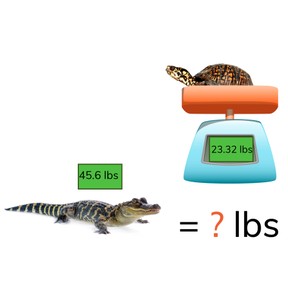



8,000 schools use Gynzy
92,000 teachers use Gynzy
1,600,000 students use Gynzy
General
Students learn to add decimal numbers that have 1 and 2 decimal places. They also learn to determine which numbers are important in a story problem.
Common core standard(s)
5.NBT.B.7
Relevance
Discuss with students that it is important to be able to add with decimal numbers with 1 and 2 decimal places, because they you can determine how much something costs, for example.
Introduction
Students practice counting on with decimal numbers with 1 or 2 decimal places. Using the snake, students add decimal numbers with 1 decimal place. Using the string, have students add decimal numbers with 2 decimal places. Divide the starting numbers between the groups of students. If you have more than 6 groups in class, you can add other starting numbers.
Example: group 1 gets the number 4. They start at the tail of the snake and go towards the head. The addition problem becomes 4+0.3= 4.3. Now they add 0.3. They continue until they reach the last square. Check the totals together.
Development
Using the number line, explain to students how to add decimal numbers with 1 decimal place. Show that you leave the first addend whole and you split the second addend (11.37) into two parts, 11 and 0.37. Using the number line, add 11 to the first addend. Then add 0.37 on the number line. The total is now 49.37. Next show an alternative method of adding the decimal numbers together. You split the first and second addend into the number before the decimal point, and the number after the decimal point. That means that, with 38.3 + 11.37 you get the addition problems 38+11 and 0.3+0.37. Calculate the answer to both of these problem and then add the two totals together to find your total. Use the next exercise to check that students understand adding decimal numbers with one and two decimal places
Students are then given a story problem. Explain to students what the steps of solving a story problem are and then solve together as a class. Using the example with chickens, add them together. Give students a story problem and ask them to solve using the given steps. Check their answers.
Check that students understand adding decimal numbers with 1 and 2 decimal numbers together by asking the following questions:
- Which methods can you use to solve adding decimal numbers with 1 and 2 decimal places?
- Which method do you like?
- How do you solve a story problem?
- What are the steps of solving a story problem?
Guided practice
Students first practice with adding decimal numbers with 1 and 2 decimal places. They are then given a story problem to solve and they must determine which decimal numbers to use for their addition problem.
Closing
Check that students are able to tell the methods that can be used to solve addition problems with decimal numbers with 1 and 2 decimal places. Also ask students to share how to solve a story problem and which steps you should take. Check their understanding using the addition problems on the interactive whiteboard.
In the last exercise, students try to find the total that matches the prize. You can do this in different ways. Students can work in groups, or give individual answers (A/B/C) on a mini dry erase board or sheet of paper. To increase excitement by choosing when to set a cover over an answer. You can erase grey squares to show which answers are correct or incorrect.
Teaching tips
Students who have difficulty with adding decimal numbers with 1 and 2 decimal places can first practice setting decimal numbers on the number line. Select a decimal number with 1 decimal place and ask students to add 0.1 each time. Then practice going from 0.9 to 1. They can then be further supported by using a decimal place value chart to see the difference between decimal numbers with 1 or 2 decimal places.
Instruction materials
Number line
Optional: Decimal Place Value Chart
The online teaching platform for interactive whiteboards and displays in schools
Save time building lessons
Manage the classroom more efficiently
Increase student engagement
Discover more!
About Gynzy
Gynzy is an online teaching platform for interactive whiteboards and displays in schools.
With a focus on elementary education, Gynzy’s Whiteboard, digital tools, and activities make it easy for teachers to save time building lessons, increase student engagement, and make classroom management more efficient.



